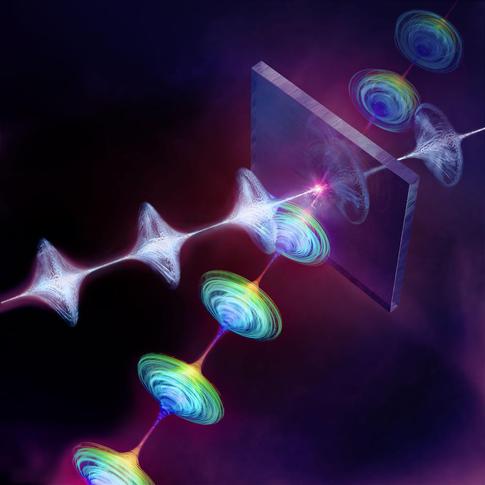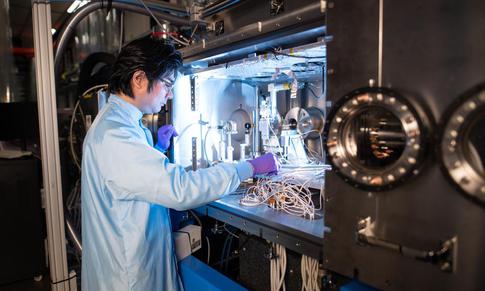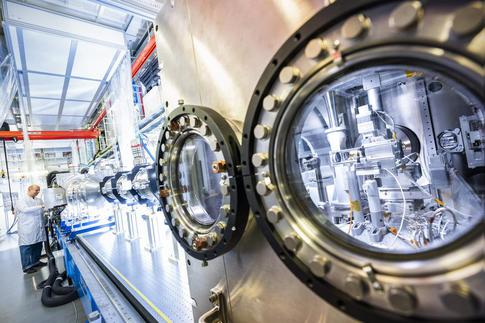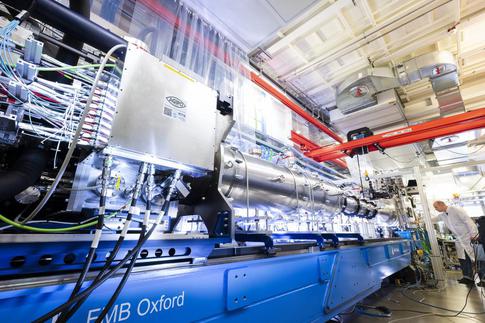XFEL: First megahertz rate timing jitter observed
https://www.xfel.eu/e35178/e35455/e35456
https://www.xfel.eu/news_and_events/news/index_eng.html
news
news
news
eng
1
1
10
both
0
1
%Y/%m/%d
Press-Release
eng,ger
 One of the ultimate goals for scientists using state-of-the-art X-ray free-electron lasers such as European XFEL is to be able to film the details of chemical and biological reactions. By stitching together a series of snapshots taken at different time intervals during a reaction, a molecular movie can be made of the process. So called pump-probe experiments use a precisely synchronised optical laser to trigger a reaction (the ‘pump’), while the X-ray laser takes a snapshot of the molecular structure at defined times during the reaction (the ‘probe’).
One of the ultimate goals for scientists using state-of-the-art X-ray free-electron lasers such as European XFEL is to be able to film the details of chemical and biological reactions. By stitching together a series of snapshots taken at different time intervals during a reaction, a molecular movie can be made of the process. So called pump-probe experiments use a precisely synchronised optical laser to trigger a reaction (the ‘pump’), while the X-ray laser takes a snapshot of the molecular structure at defined times during the reaction (the ‘probe’).
 European XFEL now generates the ultrafast and ultra-intense light pulses needed to capture these processes that occur on extremely short timescales. The pulses of X-ray light generated by European XFEL are each less than a few millionths of a billionth of a second, or a few femtoseconds – fast enough to capture the series of events in a biological or chemical reaction. An accurate synchronization of the X-ray and optical laser pulses at these timescales is, however, challenging. Furthermore, tiny variations in the alignment and path travelled by the laser pulses caused, for example, by fluctuations in air pressure, or expansion in the electrical cables, have a relatively large impact on the accuracy of this experimental set-up. This variation is known as ‘timing jitter’. For pump-probe experiments to be successful, the jitter must be kept to a minimum, and be accurately characterized so that scientists can take it into account when assessing their data.
European XFEL now generates the ultrafast and ultra-intense light pulses needed to capture these processes that occur on extremely short timescales. The pulses of X-ray light generated by European XFEL are each less than a few millionths of a billionth of a second, or a few femtoseconds – fast enough to capture the series of events in a biological or chemical reaction. An accurate synchronization of the X-ray and optical laser pulses at these timescales is, however, challenging. Furthermore, tiny variations in the alignment and path travelled by the laser pulses caused, for example, by fluctuations in air pressure, or expansion in the electrical cables, have a relatively large impact on the accuracy of this experimental set-up. This variation is known as ‘timing jitter’. For pump-probe experiments to be successful, the jitter must be kept to a minimum, and be accurately characterized so that scientists can take it into account when assessing their data. At the instrument for Single Particles, Clusters, and Biomolecules and Serial Femtosecond Crystallography (SPB/SFX) at the European XFEL, scientists have succeeded in improving and fine tuning the instrument so that the lowest ever megahertz rate timing jitter of 24 femtoseconds with an uncertainty of 12.4 femtoseconds could be observed. The report is published today in the journal Optica. This unprecedented value is down from 308 femtoseconds as reported by the team in the journal Optics Letters at the beginning of 2019. The current jitter is so minimal that experiments working with time intervals upwards of 100 femtoseconds can be performed readily without needing extra measurements or analysis to take the jitter into account. Furthermore, today’s report demonstrates the importance of accurate synchronization of optical and X-ray lasers for pump-probe experiments at XFELs.
At the instrument for Single Particles, Clusters, and Biomolecules and Serial Femtosecond Crystallography (SPB/SFX) at the European XFEL, scientists have succeeded in improving and fine tuning the instrument so that the lowest ever megahertz rate timing jitter of 24 femtoseconds with an uncertainty of 12.4 femtoseconds could be observed. The report is published today in the journal Optica. This unprecedented value is down from 308 femtoseconds as reported by the team in the journal Optics Letters at the beginning of 2019. The current jitter is so minimal that experiments working with time intervals upwards of 100 femtoseconds can be performed readily without needing extra measurements or analysis to take the jitter into account. Furthermore, today’s report demonstrates the importance of accurate synchronization of optical and X-ray lasers for pump-probe experiments at XFELs. Original publication: https://doi.org/10.1364/OPTICA.396728
Original publication: https://doi.org/10.1364/OPTICA.396728
2020/06/16
Back
First megahertz rate timing jitter observed
A report published today in the journal Optica demonstrates accurate synchronisation of optical and X-ray lasers crucial for pump-probe experiments at XFELs. These snapshots taken during a reaction are stitched together to make molecular movies.

Download [1.0 MB, 4600 x 4600]
Illustration of a pump-probe experiment in which a precisely synchronised optical laser is used to trigger a reaction (the "pump"), while the X-ray laser takes a snapshot of the molecular structure at defined times during the reaction (the "probe"). Copyright: European XFEL / Tobias Wüstefeld
Illustration of a pump-probe experiment in which a precisely synchronised optical laser is used to trigger a reaction (the "pump"), while the X-ray laser takes a snapshot of the molecular structure at defined times during the reaction (the "probe"). Copyright: European XFEL / Tobias Wüstefeld

Download [1.0 MB, 3543 x 2131]
Scientist Tokushi Sato working at the sample chamber of the SPB/SFX instrument. Copyright: European XFEL
Scientist Tokushi Sato working at the sample chamber of the SPB/SFX instrument. Copyright: European XFEL

Download [1.7 MB, 3543 x 2362]
The XPB/SFX instrument at European XFEL. Copyright: European XFEL / Jan Hosan
The XPB/SFX instrument at European XFEL. Copyright: European XFEL / Jan Hosan

Download [1.8 MB, 3543 x 2362]
The instrument for Single Particles, Clusters, and Biomolecules and Serial Femtosecond Crystallography (SPB/SFX) at the European XFEL. Copyright: European XFEL / Jan Hosan
The instrument for Single Particles, Clusters, and Biomolecules and Serial Femtosecond Crystallography (SPB/SFX) at the European XFEL. Copyright: European XFEL / Jan Hosan
Related stories:
